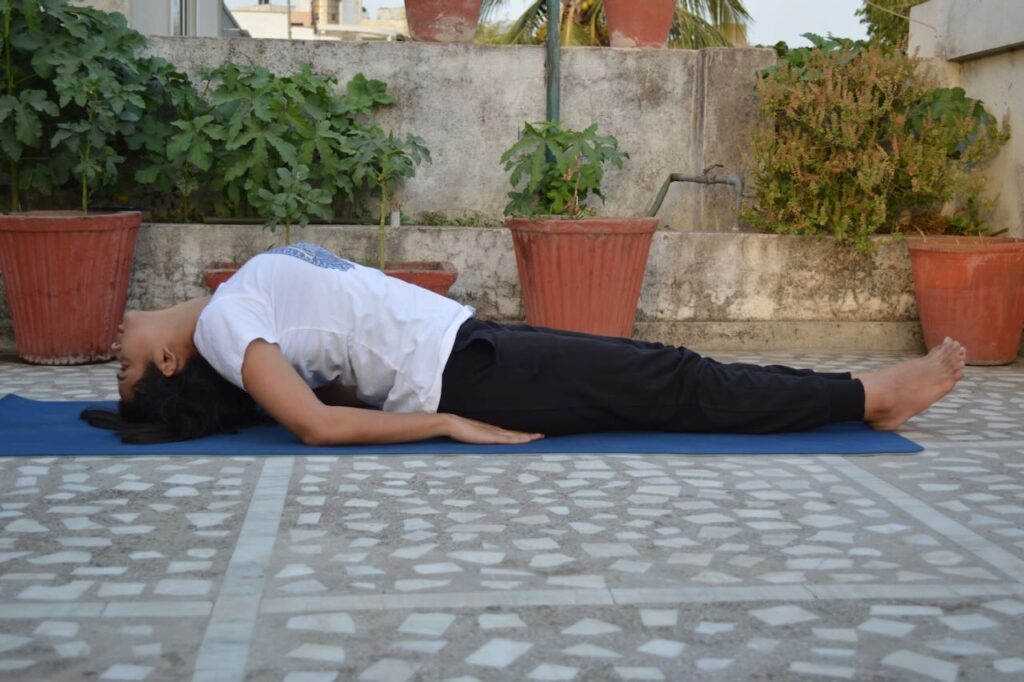Discover the Healing Magic of Matsyasana: The Fish Pose

The Fish Pose, also known as Matsyasana, is a powerful back-bending yoga pose that offers a wide range of physical, mental, and spiritual benefits. This pose is often considered to be one of the most important and therapeutic backbends in yoga, and is a great way to improve flexibility, strength, and overall well-being.
The Fish Pose is a back-bending posture that is performed while lying on the floor. The pose begins by lying on the back with the legs extended and the arms by the sides. The hands are then placed under the hips, and the elbows are pressed into the floor. The shoulders are then lifted off the floor, and the head is lowered towards the floor. The final position of the pose is with the crown of the head resting on the floor and the chest lifted towards the ceiling.
The Fish Pose is a powerful backbend that requires a great deal of strength and flexibility in the upper body. The pose is especially beneficial for those who suffer from rounded shoulders or poor posture, as it helps to open the chest and shoulders, and improve overall posture. The Fish Pose also helps to stretch the muscles in the front of the body, such as the hip flexors, which can become tight from sitting for long periods of time.
BENEFITS: Beyond the physical benefits, the Fish Pose is also believed to have a profound effect on the mind and spirit. The pose is said to promote a sense of calm and stillness, which can be beneficial for those who suffer from anxiety or stress. The Fish Pose is also believed to stimulate the thyroid gland, which is responsible for the metabolism, and can help to improve overall health.
The Fish Pose is also said to activate the Anahata chakra, which is located at the heart. This chakra is associated with love, compassion, and empathy. Activating this chakra can help to release negative emotions and promote a sense of inner peace and self-acceptance.
The practice of the Fish Pose is also believed to have a spiritual significance. The pose is said to help the practitioner to connect with the divine and attain a higher level of consciousness. It is said to help to quiet the mind, and to open the heart chakra, which is associated with spiritual enlightenment.
HOW TO: The Fish Pose can be practiced as part of a yoga or meditation practice, or it can be practiced on its own. It is important to remember that the practice of the Fish Pose should be approached with patience and compassion, and should not be rushed. It is important to listen to the body and to work within one’s own limits. It is also important to remember that the practice of the Fish Pose is not just about achieving the physical posture, but about cultivating a sense of inner peace and spiritual connection.
To begin the practice of the Fish Pose, start by lying on the back with the legs extended and the arms by the sides. Bring the hands under the hips, with the fingers pointing towards the feet. Press the elbows into the floor and lift the shoulders off the floor. Slowly lower the head towards the floor, bringing the crown of the head to the ground.
It is important to maintain a straight spine while practicing the Fish Pose. The shoulders should be relaxed and the head should be held in a neutral position. The gaze should be directed forward, with the eyes closed or with a soft gaze.
HOW LONG: The Fish Pose can be held for any amount of time, depending on the individual’s comfort level and flexibility. It is best to start with short periods of time and gradually increase the duration of the hold as the body becomes more accustomed to the posture. It is also important to listen to the body
PREPARATIVE POSES: It is important to remember that the Fish Pose should not be forced or rushed. It is important to work within one’s own limits and to gradually increase flexibility over time. There are also alternative postures that can be used as a preparation for the Fish Pose, such as Cobra Pose (Bhujangasana) and Upward Facing Dog (Urdhva Mukha Svanasana), are good options for those who are not yet ready for the full Fish Pose.
In addition to regular practice, it is also important to incorporate stretching and chest-opening exercises into one’s yoga practice to help prepare for the Fish Pose. Poses such as Cat-Cow (Marjaryasana-Bitilasana) and Camel Pose (Ustrasana) are all good options for opening the chest and preparing the body for the Fish Pose.
CONCLUSION: the Fish Pose is a powerful and therapeutic yoga posture that can offer a wide range of physical, mental and spiritual benefits. It requires patience, flexibility, and consistency to master, but with regular practice, the body can adapt and become more flexible over time. Whether you are new to yoga or a seasoned practitioner, the Fish Pose is a valuable addition to any practice, providing a sense of inner peace, self-awareness and spiritual connection. It is important to start slowly and listen to your body, don’t push yourself too hard, and remember that the practice is about the journey, not the destination.


